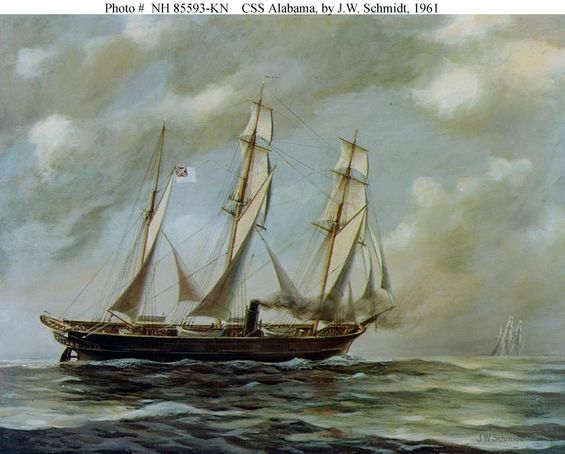Classic Ship Models 1
A PROFILE
Confederate Steam Sloop "Alabama" 1862 - 1864
The "Alabama" was placed in commission with the Confederate Navy having been constructed at Birkenhead , England. She left the shipyard disguised as a merchantman but was converted to a combat vessel and commissioned on August 24 1862. Under the command of Captain Raphael Semmes, she captured and sank over 24 Union merchant ships during the first year, as she plied the North Atlantic and West Indies.
In 1863 she welcomed in the New Year by sinking the USS "Hatteras" off Galveston on 11th January and then went down to Capetown and thence onwards to the East Indies where she destroyed almost 40 more merchantmen. Calling in at Singapore in December 1863, she continued her plunderous ways but eventually had to proceed to Cherbourg for an overhaul on June 11th 1864. On June 19th, a Union steam sloop, the "Kearsage" arrived outside the port and during the ensuing battle, caused intense damage and the "Alabama" sank. The surviving crew members were rescued by the victor and an English yacht, the "Deerhound". The wreck of the "Alabama" was eventually discovered by the French Navy in the 1980's
General specifications of the "Alabama": Length 67 metres - Beam 9.65 metres - Draft 5.38 metres - Displacement 1050 tons - Motive power 2 x 300 HP horiz. steam engines - single screw - 13 knots - Complement: 145 officers and crew - Armament 6x15 kg cannons, 1x50 kg & 1x31 kg cannons.
THE MODEL
CSS "Alabama" 1862 -1864
This was my third model which combined sail with motive power, the others being more recently built 20th century European training vessels which feature later on in this catalogue. The "Alabama" had a very short life but was quite unique in her design and firepower as explained above. This particular kit was from the Mamoli company of Italy and the instructions were fairly complex and had to be carefully studied. It would not be suitable for an inexperienced person as it required a fair amount of personal skill and adaptation to reach a polished finish.
The end result is satisfactory but the time taken - about 23 weeks (admittedly in available free time only) was rather more than expected for the a model of her length - 694 mms, height 347 mms, beam 85mms and a scale
of 1:120. The hull is double planked but the kit also supplied minute sections of green coloured timbers to emulate copper plating. I chose not to use these but settled for a metallic copper painted boot topping. The stern section, including the
rudder and propellor, were complex in design with frame for the rudder having a rope connection to a winch on the afterdeck. The gunwales were unusual in design having an inner and outer component with a sizeable gap between them.
As no chain plates were supplied, these were fashioned from brass wire which worked well and looked authentic. The overall size of the model precluded too much detail on deck. Similarly, the size of the rigging blocks required a very steady hand and a pair of tweezers to thread. The lifeboats and falls together with the davits worked well as did the fitting of the masts, yards and bowsprit. Tapering of these was done by hand due to their small dimensions which made them susceptable to breakage.
The period of production , working on average about 2 hours daily for 5 days per week, was from November 2011 until the end of April 2012.
Updated news: Our granddaughter Rachel and husband Garth loved the history of this vessel and now enjoy its presence in the home.


